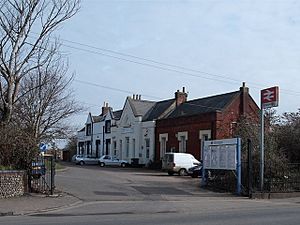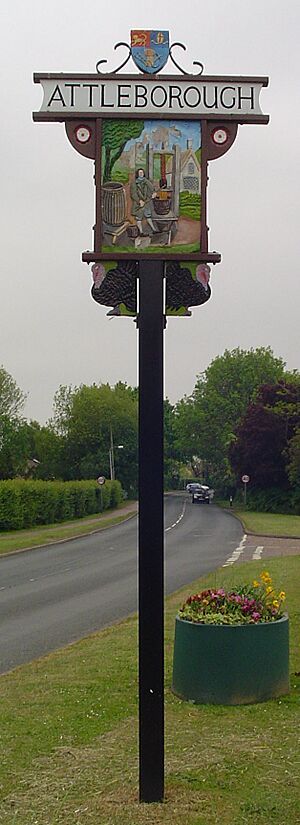Attleborough facts for kids
Quick facts for kids Attleborough |
|
|---|---|
 Attleborough railway station |
|
| Area | 21.9 km2 (8.5 sq mi) |
| Population | 10,482 (2011 Census) |
| • Density | 479/km2 (1,240/sq mi) |
| OS grid reference | TM049954 |
| Civil parish |
|
| District | |
| Shire county | |
| Region | |
| Country | England |
| Sovereign state | United Kingdom |
| Post town | Attleborough |
| Postcode district | NR17 |
| Dialling code | 01953 |
| Police | Norfolk |
| Fire | Norfolk |
| Ambulance | East of England |
| EU Parliament | East of England |
| UK Parliament |
|
| Website | Attleborough Town Council |
Attleborough is a market town and civil parish in Norfolk, England. It is located on the A11 road between Norwich and Thetford. The town is part of the Breckland area. It covers about 21.9 square kilometres (8.5 square miles).
In 2011, about 10,482 people lived in Attleborough. They lived in 4,481 homes. By 2021, the population had grown to 11,232 people.
Attleborough is in the Mid-Norfolk area for the UK Parliament. Since 2010, George Freeman from the Conservative Party has been the local Member of Parliament (MP).
Attleborough railway station offers train services. You can travel to Norwich and Cambridge from here.
Contents
History of Attleborough
The town of Attleborough has a long history. It was first settled by the Anglo-Saxons. No one knows exactly when it started. Some people think it was founded by someone named Atlinge. The word burgh in its name means it was an early fortified place.
In the Domesday Book of 1085, the town was called Attleburc. This book was a big survey of England.
After the Danes took over Thetford, the Saxons gathered their forces in Attleborough. They likely built some defenses. Even though the Saxons fought hard, the Danes won. Later, powerful Danish families ruled the local areas. When William the Conqueror arrived, things became more stable.
The Mortimer family took over from the Danes. They ruled Attleborough for over 300 years. In the 1300s, the Mortimer family built the Chapel of the Holy Cross. This chapel is now part of Attleborough Church. Later, the nave and aisles were added for more people.
When Henry VIII was king, he closed many monasteries. This was called the Dissolution of the Monasteries. A man named Robert Radcliffe destroyed much of the church building. He used the materials to build a road. This left Attleborough Church with its tower at the east end.
In 1559, a big fire destroyed much of Attleborough. The Griffin Hotel was built around this time. Prisoners used to stay in its cellars overnight. They were on their way to trials in Thetford. People would gather to watch the prisoners arrive. This led to a fair called Attleborough Rogues Fair. It was held on the last Thursday in March.
The town has had the right to hold a weekly market since 1285. This market is still held every Thursday. It returned to Queen's Square in 2004, where it is thought to have started.
The first turnpike road in England is said to have been in Attleborough. This was at the end of the 1600s. Turnpike roads were early toll roads. People paid to use them to help pay for repairs.
In 1801, the first national census counted 1,333 people in Attleborough. By 1845, the population was almost 2,000. The railway arrived in 1845, connecting Norwich to Brandon.
Attleborough once had six inns or pubs. These included The Griffin, The Angel, The Bear, The Cock, The Crown, and The White Horse. Today, The Griffin, The Bear, and The Cock are still pubs. The Crown is now a youth centre. The Angel is a building society office. There are also two newer pubs, The London Tavern and The Mulberry Tree.
In 1863, a corn exchange was built. Farmers used it to trade grain. In 1896, the Gaymer's cider factory opened. It became the biggest employer in town. The factory no longer makes cider. It is now a chicken processing plant. The corn exchange is now a warehouse.
During the First World War, 96 men from Attleborough died. In the 1920s, Attleborough continued to be a busy market town. In the 1930s, turkey sales made the market very popular. Thousands of turkeys were sold each year on Michaelmas Day.
In the early 1930s, the Corn Hall became a cinema. It was very popular in the 1940s. In the 1930s, the town got gas lighting. A gas works was built, and gas was slowly piped into homes.
The old post office became the Doric Restaurant in 1939. It is now the town hall. A new post office was built in Exchange Street.
During the Second World War, there were two airfields nearby. These were at Deopham Green and Old Buckenham.
The town did not change much in the 1950s. However, some famous London brothers lived in a local inn for a time. In the 1960s, new families moved to Attleborough. New housing areas were planned. The first was the Cyprus Estate. Later, Fairfields and Ollands were built. A large estate was built in the south of town in the 1990s.
The main road through town, the A11, became very busy. In the 1970s, a one-way system was created. But traffic kept growing. So, the Attleborough bypass was opened in 1984. The bypass was made wider in 2007. This helped traffic flow better between Thetford and Norwich.
Churches in Attleborough
The main church is the parish church of the Assumption of the Blessed Virgin Mary. Parts of it are from the Norman times. Other parts are from the 14th century. The east end is Norman, and the nave is from the late 1300s. A special screen inside the church is very old and beautiful.
The Eastern Baptist Association meets at the Baptist church in Leys Lane. The Attleborough Methodist church is on London Road. It no longer holds regular services. However, it offers rooms for community groups to use. This building was designed in a Gothic Revival style. It replaced an older Methodist building in 1913.
Schools in Attleborough
Attleborough has three schools. These are Attleborough Academy, Rosecroft Primary School, and Attleborough Primary School. Wymondham College, a large state boarding school, is also close to the town.
Local Businesses
Banham Poultry, a large chicken processing company, is based in Attleborough.
Famous People from Attleborough
- The composer Malcolm Arnold lived here from the late 1980s until he passed away in 2006.
- Professional footballers John and Justin Fashanu lived and went to school in Attleborough.
- Racing driver Ayrton Senna (1960–1994) lived in Attleborough when he first started his international racing career.
- Brandon Francis, an actor and writer, also lived and went to school in Attleborough.
Images for kids
See also
 In Spanish: Attleborough (Norfolk) para niños
In Spanish: Attleborough (Norfolk) para niños






